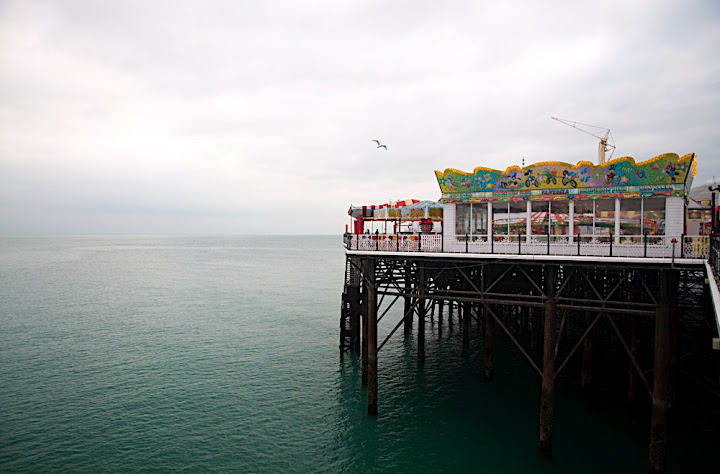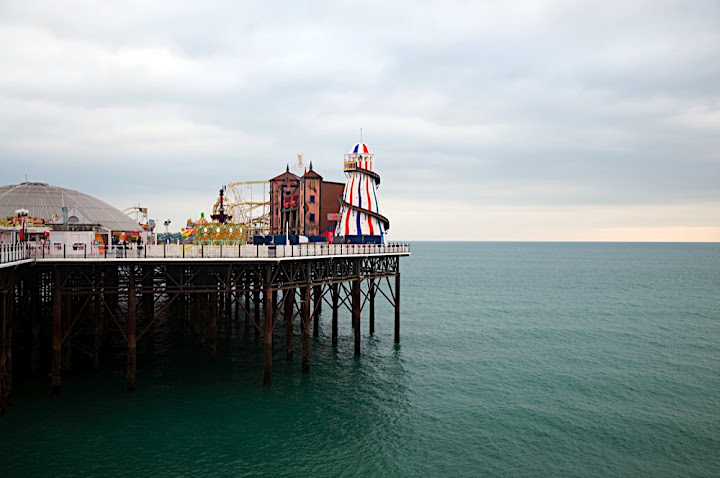
I had just come back to London from a day trip to Brighton when I read Chris DeWolf’s post on the controversy surrounding Montreal’s proposed anti-mask bylaw. It seemed appropriate to respond with a first (and hopefully regular) UK Dispatch from the English city whose name is synonymous with pleasure, party and carnivalesque behaviour. To stretch analogies across the big pond, you could probably think of this place as a sort of Niagara Falls. The photos are all taken from the Palace Pier, which is a 524m long “jetée” cluttered with blinking lights, loud noises, saturated colours, flashing arcades, dangerous looking roller coasters, even more dangerous looking “rides”, candy floss (cotton candy), candy apples, candy, fun, bling, sound of money.
Looking toward the charred skeleton of the old West Pier.
The “event called Brighton” (1) emerged at the turn of the 19th century from two distinct phenomena. This little fishing town had quickly become a sought after destination for health as in these days physicians would often prescribe sea-water cures to their patients. Its proximity to London also playing heavily in its favour, it was there that George IV, then Prince Regent, chose to build his famous pavilion (fans of chinoiseries click here) designed -it seems- for the sole purpose of entertaining guests at lavish parties choreographed according to the linear succession of rooms. I couldn’t help thinking of Peter Greenaway’s “The Cook, The Thief, His Wife and Her Lover” while moving through the spaces…
The town was transformed over the years and so were its demographics. The phenomenon of sea-water cures, while still popular near the end of the 19th century, was quickly being overtaken by the growing industry of pleasure. Brighton and its beach became a destination where, to the horror of many, “classes mixed freely” (1). The depravation and questionable morality at play seem to have been major factors influencing Queen Victoria’s decision to take the royals out of the “carnival” of Brighton. But this breaking down of conformity and norms, as Rob Shields points out, is exactly the intended purpose of the carnival (not shocking royals into packing…): “it is the occasion for the enactment of alternative, utopian social arrangements.” (1)

The carnivalesque, as defined by Mikhail Bakhtin, is a “temporary suspension, both ideal and real, of hierarchical rank [which] created during carnival time a special type communication impossible in everyday life. This led to the creation of a special form of marketplace speech and gesture, frank and free, permitting no distance between those who came in contact with each other and liberating them from norms of etiquette and decency imposed at other times.” (2)
But the modern crowds that “took over” Brighton were nothing compared to real medieval carnival crowds (from which Bakhtin derived his concept). A certain type of conformity still regulated behaviour, however outlandish. When pleasure turns into leisure, the carnival turns into a “holiday mood”. But regardless, “the much-lamented anonimity of these holiday crowds may be seen as more of a metaphor of the carnivalesque loss of identity, the crowd’s inclusive, cross-class character, the erosion of bourgeois privacy and marks of a social order founded on distinction.” (1) In other words, the “anonymous” crowd does in a way react to an over emphasizing of private distinction. Its behaviour sharply cutting through accepted social norms.

I’ve started this article as a reply to Chris’ post and I should perhaps wrap up and clearly state my intention. What this whole reading of the carnival gives use is a glimpse into the ambivalence present in all people. This ambivalence Bakhtin describes as inherent to the dialogic nature of being (a person is not only this, but also this). In other words we all have conflicting sides to our personalities that need to be acted out. What the carnivalesque is, in a way, is a tactic that allow our socially “less palatable” side to come out by breaking down social barriers and norms. And yes, this usually takes on a grotesque form with out-of-scale costumes and, of course, face masks. And there is, as stated above, a clear social and, perhaps less evident, political, power behind this tactic because it orchestrates a social (dis)order so radically different from prevailing ones that it forces criticism. And I do think we see similar orchestrations happening at protests where a version of the carnivalesque as political tactic becomes quite efficient in “getting the message across”.
Ah, and Brighton was great. There is nothing like a beach town in the middle of winter. Grey skies, cold wind-swept promenades, quasi-deserted amusement parks, and yes, loud groups of costumed first year university students invading the streets by night fall, acting out their “rite de passage”.
(1) Shields, Rob. “Places on the Margin: Alternative Geographies of Modernity, Routledge, London, 1991.
(2) For the carnivalesque see Mikhail Bakhtin.

3 comments
Wonderful. And for heaven’s sakes, if you’re at the British seaside try and get a good fish ‘n chips — and report. Thanks.
I’m sure this is not what you want to hear: the fish ‘n chips I had for lunch was by far the worst I’ve ever had… The pale batter and chips were soggy as a sea wind on a rainy day. Fitting, I guess, but still surprising: the place was recommended by a real Brightonian.
We are miles away from the banquet hall of George IV. But being royal -and a bon vivant, he had the luxury (necessity?) to import his chefs from France.
I was born in Brighton and later returned to go to uni there, so it’s nice to see it featured, and I do like your photos, but I want to say that it’s much more than just a seaside town – it’s the best and most thriving English city south of London. Also, carnivalesque is crucial to Brighton life but I don’t reckon the Palace Pier is where you’ll find it! Brighton is where the Schnews was born, in a squatted courthouse – now there’s some radical carnival for you (http://www.schnews.org.uk/)
And if you want more English seaside, try Margate…!
(My sympathies for the fish and chips. Keep trying, and don’t forget the mushy peas and pickled onion.)